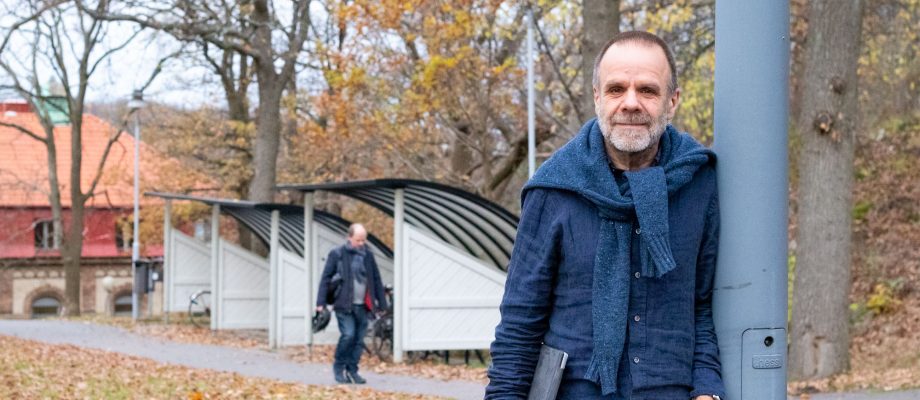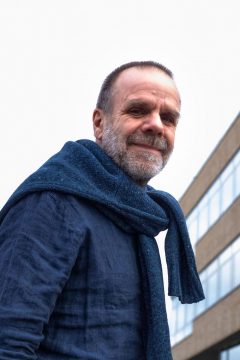ENVIRONMENTAL EFFORTS. After 15 years as the faculty’s environmental coordinator, Mats Sandberg soon will be passing on the baton. During his time on the job, environmental management systems, sorting of waste, the Planet seminar series and the bicycle workshop have come into being. But clearly more environmental efforts are needed at Sahlgrenska Academy.
Sahlgrenska Academy currently is looking for the next environmental coordinator, who can take over when Sandberg leaves. You can read the advertisement in Akademiliv (Academy Life) here:https://akademiliv.se/2019/11/61730/
Sandberg was asked if he could imagine being the environmental coordinator by Pam Fredman, who was then dean, and Irja Persson Utterhall, head of the Faculty Office. Since Sandberg and Fredman were researchers in related fields, she knew of his commitment to the environment and nature. By that time, he had already been cycling to work from his home in Pixbo daily for many years, mainly for environmental reasons:
“It takes about 40 minutes, including the shower I need to take when I arrive at work. That’s comparable to other means of transport, and I get exercise in the bargain,” says Sandberg.
His own stubborn bicycle commute may have inspired some of the Environment Council’s bicycle initiatives: a covered bicycle rack, participation in the Cycle Challenge, bicycle service on campus in both spring and autumn and most recently a well-equipped bicycle workshop, which is available to both employees and students at Medicinareberget behind Zoologen.
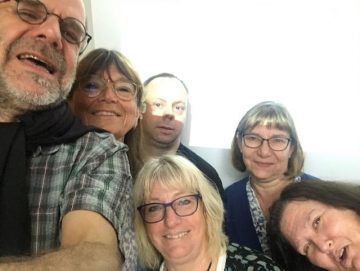
The good examples became trailblazers
As environmental coordinator, Mats Sandberg was responsible for calling meetings of the Environment Council, where all departments, Campus Service, Core Facilities, the Faculty Office and students participate with their appointed representatives to coordinate environmental action in their area. Previously, more or less active environmental efforts took place in various institutes and departments at Sahlgrenska Academy. In 2006, to accelerate the work towards certification of the faculty according to the ISO 14001 environmental management system, the Environment Council initially highlighted some of the departments and organizations that had already come a long way: Clinical Genetics, the Odontology Building and Wallenberg Laboratory.
“Environmental action was already well organized there. Strategic environmental action means that you can avoid audit discrepancies that otherwise need to be handled and reported. As a bonus, you have a better work environment for handling things such as hazardous chemicals. So it is both smart and efficient to integrate environmental action into our operations,” says Sandberg.
“All environmental action at the faculty is now coordinated by the Environment Council, which meets monthly. These are pleasant gatherings with a really nice and well-functioning group. We report to management, which provides feedback on our work.”
In recent years Rita Grandér, environmental coordinator for the Institute of Neuroscience and Physiology, has become increasingly responsible for overall environmental action as environmental coordinator for the entire faculty, and she now shares the assignment with Sandberg.
Orderliness in the lab
Compared to when he started as an environmental coordinator 15 years ago, Mats Sandberg thinks it has become easier to pursue environmental issues at the faculty:
“The environment and sustainable development have become an increasingly important issue for the world around us, and also for our faculty. Having an assignment that focuses on issues that most people nowadays consider important is really stimulating.”
In early 2004 the assignment consisted primarily of coordinating Sahlgrenska Academy’s adaptation to the ISO 14001 environmental management system. This advanced standard for environmental management provides tools for reviewing and improving environmental action in the organizations. An essential part of ISO 14001 is regular visits by both internal and external auditors. Among other things, they check on whether environmental efforts follow the university’s action plan.
“The environmental auditors say they also sense that environmental issues have been given greater prominence at Sahlgrenska Academy, also in the organizations. They see that the labs are orderly and that the departments and institutions take environmental issues more and more seriously,” says Sandberg, but he notes that despite the good orderliness in the labs, there is still work to be done:
“The most common deviation reported by the auditors is deficiencies in risk assessments of work with hazardous chemicals, especially CMR substances – those that are carcinogenic, mutagenic or toxic for reproduction.”
Solar cells on the roof
The Environment Council also devoted a lot of time to establishing a waste sorting system, for which Sahlgrenska Academy enlisted the help of an assistant environmental coordinator hired for the project. Introduction of the KLARA chemical handling system, for which Rita Grandér now has primary responsibility, has also required a lot of effort.

Akademiska Hus is installing almost 4,000 square meters of solar panels on the roofs. When they are operational at the end of next year, they will generate 675,000 kilowatt hours of renewable electricity per year.
“That’s really fantastic and great. The Environment Council probably served as a catalyst for this because it provided SEK 150,000 in grants from the university’s climate fund,” says Sandberg, whose application for a solar cell investment granted almost three years ago originally applied to funds for a solar tracker on a stand.
“For various reasons this project did not materialize, but the funds are now invested together with Akademiska Hus on solar panels on the roof of the building Lyktan instead.”
Statutory sustainability
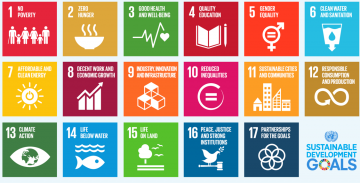
During the years the Environment Council has been in operation, development has really progressed, but there is still much to do, and the nature of the work will probably change somewhat, he notes.
“The closer we come to 2030, the more attention will be given to the Academy’s climate impact and Agenda2030. Like most higher education institutions in Sweden, the University of Gothenburg has joined the Climate Framework. It will be very interesting to follow that work.”
“The Swedish Higher Education Act clearly states that we are to promote sustainable development. All programs currently have some elements of this, and some programs have come a long way. But many of our courses and academic programs still have a lot of work ahead of them.”
Mats Sandberg participated in the academy’s first action plan for integrating sustainable development in educational programs beginning in 2007 and has presented introductory lectures on the subject since 2008.
According to a proposal to the government from the Agenda2030 delegation, the Swedish Higher Education Authority (UKÄ) will be tasked with reevaluating work on sustainable development at higher education institutions no later than 2022 to determine whether higher education meets the requirements of the Higher Education Act in teaching.
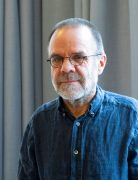 “We need to create stable development that does not just rely on real enthusiasts. Integrating sustainable development based on the Higher Education Act and Agenda2030 into the programs in a professional and long-term manner will be a major challenge in the near future,” says Sandberg. He adds that Sahlgrenska Academy’s network for integrating sustainable development in teaching, which Gunilla Priebe is in charge of calling participants to meetings and Sandberg has been involved in, started this major undertaking through the action plan prepared for the 2019–2020 period.
“We need to create stable development that does not just rely on real enthusiasts. Integrating sustainable development based on the Higher Education Act and Agenda2030 into the programs in a professional and long-term manner will be a major challenge in the near future,” says Sandberg. He adds that Sahlgrenska Academy’s network for integrating sustainable development in teaching, which Gunilla Priebe is in charge of calling participants to meetings and Sandberg has been involved in, started this major undertaking through the action plan prepared for the 2019–2020 period.
“The action plan lists almost 20 priorities, and its proposals include university-wide intended learning outcomes in sustainable development, more time for teacher training and better dissemination of the good examples that exist today at the Academy.”
Joy of discovery
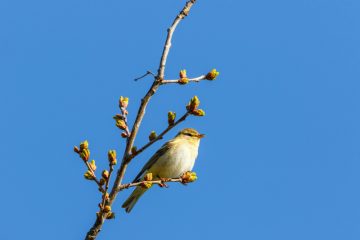
Being an environmental coordinator now takes 10 percent of his working hours. As a professor at the Institute of Biomedicine, his main job involves research on protective mechanisms in the brain after oxygen deficiency and teaching histology in the medical program.
“I have no direct connection with environmental issues there. The contrasts are interesting, and it is enriching to have such diverse and widely differing work assignments,” says Sandberg, who adds that he is also an old member of the Nature and Youth Sweden environmental organization.
His path to environmental consciousness probably started in Swedish Scouting, then gravitated to Nature and Youth Sweden and now he is locally involved in the Swedish Society for Nature Conservation in his home municipality, Härryda. His interest in birds has also followed him all his life.
“It is wonderful to go out in early spring, follow which migratory birds show up and identify them based on their calls. There is joy of discovery in being a birdwatcher, which may also be connected with the curiosity I feel before conducting research,” says Sandberg, who hopes to gear up his birdwatching when he retires in the spring just in time for the return of the willow warblers.
TEXT AND PHOTO: ELIN LINDSTRÖM

